Annette Sharp tells of the havoc wreaked by south coast fires
When the bushfires struck the south coast, Annette Sharp obsessively checked the Fires Near Me app. After it glitched for hours it finally reloaded with an ominous warning: “Too Late To Leave”. READ HER STORY HERE.
- RFS chief clashes with government over fire funding
- P!nk donates $500K to fireys as Barber raises $11m
For a few hours on New Year’s Eve, the official NSW Rural Fire Service advice to residents and holiday-makers staying in the tiny hamlets and bays from Batemans Bay and further south was decisive and clear.
“People in bushfire areas between Batemans Bay & Bega should move towards a larger town such as Narooma, Moruya, Bega & Batemans Bay before 8am,” the RFS posted to social media sometime late Monday.
Then the westerly picked up at 6am on Tuesday, the sky darkened, the power went out and confusion and panic took hold.
In the hours and days that followed, the coastal communities and towns listed in the RFS Tweet, plus dozens of smaller towns scattered south to the Victorian border, would come to a shuddering standstill as power poles and lines toppled and burned in the catastrophic bushfires that have laid waste to the region this past week plunging it into chaos.
Life as we know it — and take for granted — disappeared.
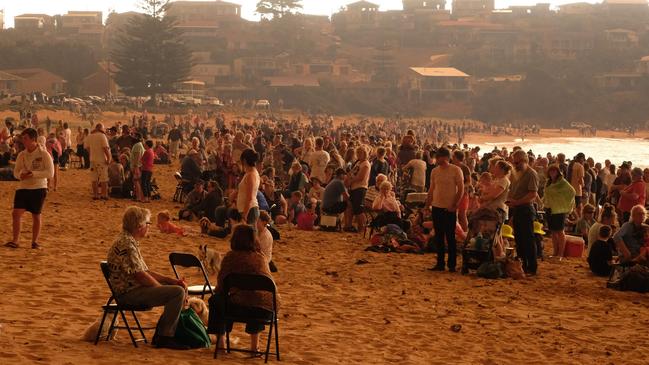
Petrol bowsers and traffic lights stopped working, ATMs went offline refusing to dispense money, shops and supermarkets shut, a “cash only” society sprang up, people queued in the street for perishable food that had started to spoil and was about to be thrown out and the truly desperate, having succumb to siege mentality, began stealing garden hoses and that newly rare and highly prized commodity, petrol.
All of this, even the warm beer still being served at safe-havens to preserve morale, the stoic and hardy locals of the far south coast could endure.
They are accustomed to life without 24-hour consumerism and with a notoriously patchy telecommunications network.
MORE NEWS
$7m mega-mansion reno approved after court fight
Food trends in Sydney over the past decade
Old shows make a comeback in 2020 TV reboots
What they couldn’t come to terms with, in this age of information overload, online banking and billing, online-via-Karachi telecomms fixes and Menulog deliveries, was the collapse of mobile phone networks and the internet upon which our society has come to heavily rely.
Without mobile phones and any evidence of on-the-ground authorities taking charge of the rapidly expanding crisis, how would anyone survive this living hell?
For those in the danger zone, including me and my family, there were dozens of questions to which we struggled to find answers.
Were we in danger? Where was the closest fire? Which roads were open to us for evacuation? When would the power be reconnected? What had happened to our mobile data reception? Weren’t we safe on the beachfront with the lifesaving southerly blowing? Had we made a mistake pulling out our reliable old landline phones? Where could we get petrol, bread, UHT milk, candles, batteries … a much needed hot cup of tea?
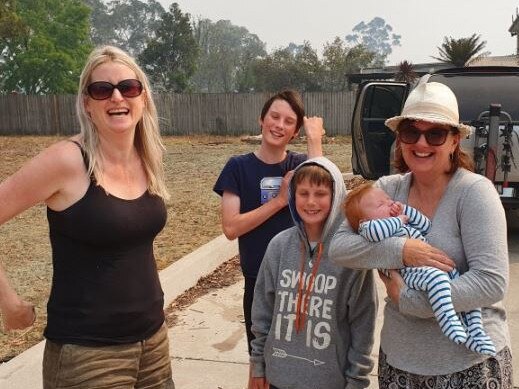
The RFS’s problem-plagued Fires Near Me app glitched for hours as residents and campers alike hammered unresponsive mobile phones draining batteries more quickly in their search to find answers.
When the RFS app did reload, the warning advice had changed.
“Too Late To Leave” it said ominously.
Charred gum leaves started to rain down and the sky darkened to a hot ochre streaked bruise and went black as my husband and I – seasonal summer residents of a humble 50-year-old Broulee beachfront shack built by his parents in the 1960s – packed our three teenage daughters, dog, few valuables and hastily repacked bags into the family car and set off for the closest town, Moruya, to get information and petrol.
With less than a quarter of a tank of fuel in the car, petrol was our priority.
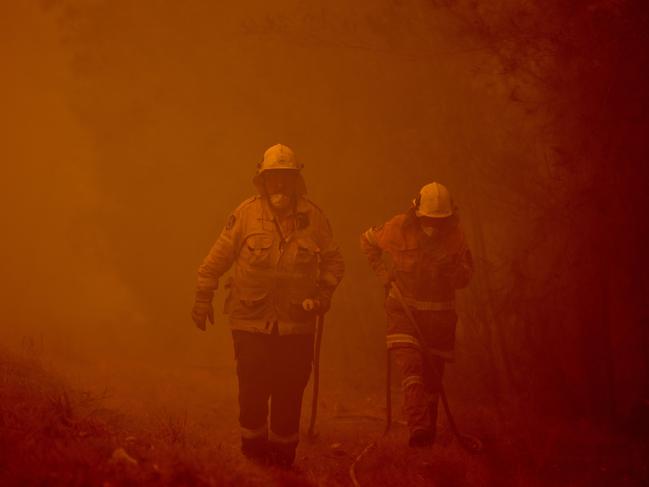
We would need it if we were to evacuate and were already nervous about strained petrol reserves in the region after running out of fuel a week earlier on the trip down the coast from our Sydney home.
On that journey, undertaken on December 23, we had, as per family tradition, hooked up our trailer boat and packed it to the brim with surfboards, inflatable toys, pushbikes, Christmas presents, the dog bed and two eskies containing the makings of our Christmas Day feast – including a sizeable leg of ham and champagne – and set off on our five-and-a-half hour annual pilgrimage south confident we’d arrive by dinner and be reunited with my husband’s family including his sister who lives in the area.
When bushfire closed the Princes Highway at our halfway point, Nowra, we turned north-west and took the much longer and slower route through Kangaroo Valley, Goulburn, Braidwood, Cooma and Bega.
The detour would add six hours to our trip but nothing was going to derail this year’s south coast holiday.
We had a vital family appointment to keep.
It had been my mother-in-law’s final wish to have her ashes committed to the sea in front of the little weekender where she and her pre-deceased husband had, for almost 60 years, fished, foraged and entertained family and friends. Her death in October set in motion plans for her children to honour that wish during the Christmas break.

With no petrol stations open south of Cooma on our epic 12-hour two-fuel-tank odyssey, we would be forced to pull into a closed Shell garage in Narooma at around 12.30am on Christmas Eve and go in search of three metres of garden hose to enable my industrious husband to siphon petrol from our boat to our car to complete the trip.
Exhausted, we searched in vain for a length of hose for an hour and were preparing to sleep in the car alongside the heartening petrol bowser when out of nowhere Craig, a local, pulled up to offer assistance.
“Do you have a knife?” he asked as one of my daughter’s audibly gasped fearing our ordeal would culminate in a highway robbery.
Five minutes later he was back with the hose we needed and the siphon was underway, Craig remaining with us until we were safely on our way.
We finally climbed into our beds at 3.30am, 14 hours after leaving Sydney, exhausted but confident we’d left the closest fire-front 140km behind us near Nowra.
Six days later, on New Year’s Eve, found us again obsessed with petrol.
By 11am, an hour into this new crisis, the main street of Moruya was strewn with well-meaning local citizens in hi-viz shirts attempting to manage vehicles impacted by the blackout of the town’s single set of traffic lights and a roadblock established to prevent drivers fleeing north on the closed Princes Highway.
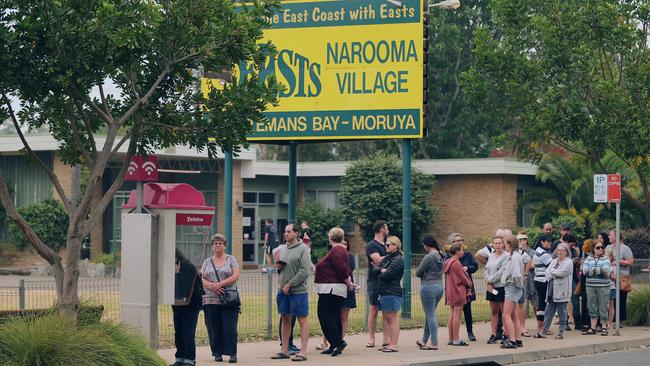
At the first petrol station we came across, four young women attempted to calm a queue of worried drivers astonished to find, as were we, Moruya was without power and all fuel pumps and ATMs were down.
On New Year’s Eve this town would normally be a hive of activity with locals snapping up provisions for New Year’s parties and the New Year’s public holiday. This New Year’s everything, including Woolworths, was shut.
Empty-handed, we attempted a hasty retreat but not first without having to fast-talk our way past the hi-viz wardens at the roadblock we’d encountered earlier, most of whom had a different view on road closures and the route back to Broulee.
Back at the old house we began hosing gutters, filling buckets, gathering woollen blankets and checking in with relatives located in another house down the road as three separate fires sprang within plain sight – one to the north behind Malua Bay, a second to the west in bushland behind the Broulee Primary School and a third improbably in a patch of grass on the beachfront to our south.
A wild, blustering but mercifully early southerly fanned two of the fires away from us as three water-dumping helicopters descended on them and locals started filling eskies and buckets with water and running to the beach to extinguish the fire closest to the family shack weekender.
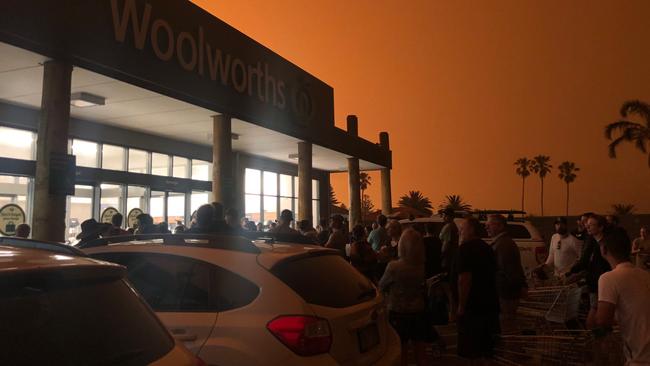
The thud of helicopter blades would bring comfort and fear over the next 72 hours as the heroic pilots of Air-Crane (“Elvis”) and Bell Huey choppers repeatedly drew water from the ocean in front of the tired family shack whose thin walls rattled for three days as the choppers relentlessly came and went.
The little house, built by a man who knew nothing of luxury having been raised in depression-era Ingleburn in the 1920s and who discovered Broulee during a camping trip, is as humble as they come.
Just an elevated timber verandah really, with four small uninsulated rooms attached, from which to gain greatest vantage of the sea, the stars and a rustic outdoor fireplace fashioned from boulders of Moruya granite – “The very same as is in Sydney Harbour Bridge..” as my father-in-law told me repeatedly before his death six years ago.
The interior of the house, into which every redundant ageing household appliance, chair, bed, coffee table and TV set has been retired during its almost six decade life, is linoleum. Lino flooring. Lino wall cladding. Not exactly fire-retardant and drafty as an outdoor dunny in the winter months.
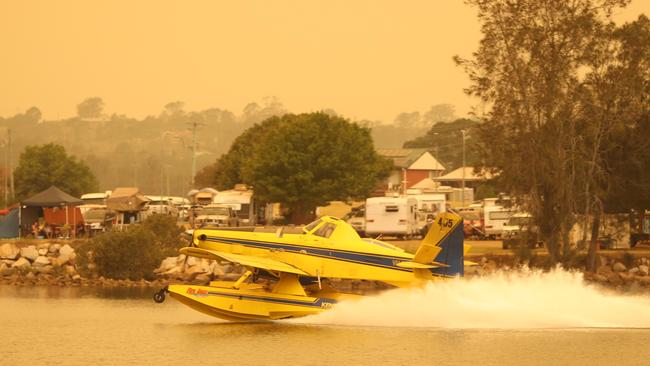
It will certainly never feature on an episode of Grand Designs yet the little shack is much-loved and we would hate to see it consumed by fire so we bunkered down, sustained by the last of the Christmas ham, cheese, crackers, fruit and the largest bowl of homemade brandy butter any has ever seen.
A dilapidated rusted BBQ discovered in the cluttered garage with a little gas left in its cylinder permitted us to boil water in a pot for a much-needed cup of tea and cook an egg. Sadly we had no such luck finding two C-cell batteries for an old transistor radio also dug out of its hiding place.
We would spend the next two days observing the last RFS “Too Late To Leave” warning while exploring – on foot so as to conserve petrol – the closest communal safe zone. A nearby boat ramp was favoured.
The car radio provided what little information could be sourced from a local ABC station, though at some risk to the life of the vehicle’s battery as we spent hours in the stationary car listening to radio and charging data-and-receptionless mobile phones.
Information obtained from the radio conflicted wildly at times with local intel gathered on the ground by neighbours and family members adding to uncertainty and growing panic.
The nearby historic timber town of Mogo had burnt down or had it? It hadn’t. The local primary school too? Fortunately not.
Then a small miracle occurred. Overnight on Wednesday communications were restored. The electricity outage would last many more days (and at time of publication still continues) but we hoped to drag some more charge out of the car battery for a bushfire update.
By Thursday we had a new RFS advice – evacuate before conditions deteriorated yesterday.
After gathering family members hastily together and committing Nanny to the sea with a few well-chosen words around 10am, a nephew joined the slow crawl north to Sydney on the blocked Princes Highway while my own family packed up and tried to establish if it was possible to buy fuel in Batemans Bay.
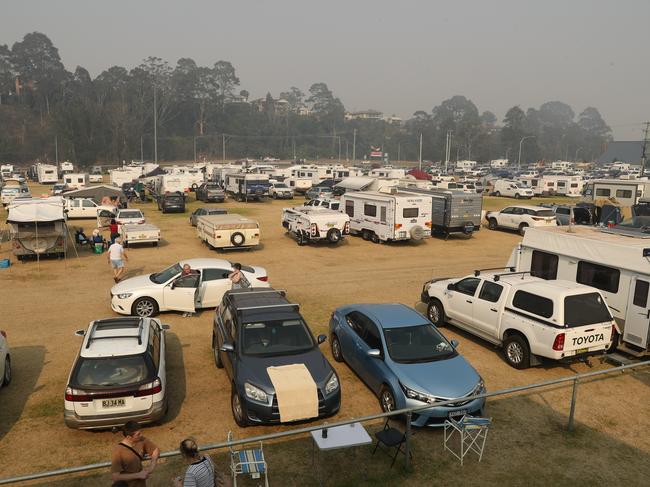
When this information still evaded us, my husband steeled himself for another boat-to-car siphon, an idea of which made his stomach roil. No one wants petrol in their mouth.
At 5pm we set off, cheered by the thought of joining a productive fuel queue – along with fire trucks and police – at the only working petrol station open in the Bay, a Caltex north of the Clyde River, that had a generator and working EFTPOS.
Our escape route, the Princes Highway, remained closed at Milton however so we determined to head back into the Bay for dinner at a Thai restaurant that looked to have power.
We would kill another five hours waiting for the road to reopen and the growing 12-hour traffic queue snaking its way north to Sydney to start moving.
When it hadn’t by 10pm, we turned south and headed back past the devastated communities of Rosedale and the still smouldering Malua Bay – to our darkened shack at Broulee. The kids we instructed to sleep in their clothes on stripped-bare mattresses. We promised to try again at first light.
At 4.30am Friday we were up and within 30 minutes on the road again.
This time we were prepared to camp in our car for as long as it took to get home.
Our evacuation ended up taking 10 hours, from Broulee to Sydney.
We now nervously await news of relatives who evacuated south to a riverside campsite in Moruya and of communities holding on to hope in the face of a massive environmental challenge.

